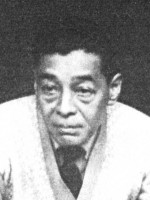A Page of Madness is a japonais film of genre Drama directed by Teinosuke Kinugasa with Masao Inoue
A Page of Madness (1926)
Kurutta Ippēji ou Kurutta Ichipeiji

If you like this film, let us know!
A Page of Madness (狂った一頁, Kurutta Ippēji or Kurutta Ichipeiji) is a silent film by Japanese film director Teinosuke Kinugasa, made in 1926. It was lost for forty-five years until being rediscovered by Kinugasa in his storehouse in 1971. The film is the product of an avant-garde group of artists in Japan known as the Shinkankaku-ha (or School of New Perceptions) who tried to overcome naturalistic representation.
Yasunari Kawabata, who would win the Nobel Prize for Literature in 1968, was credited on the film with the original story. He is often cited as the film's screenwriter, and a version of the scenario is printed in his complete works, but the scenario is now considered a collaboration between Kawabata, Kinugasa, Banko Sawada, and Minoru Inuzuka.
Synopsis
The film takes place in an asylum. Although cut together in an ever maddening maelstrom, the film loosely tells the story of the janitor of the asylum. His wife is one of the patients. One day their daughter shows up at the asylum to tell her mother about her engagement. This sets off a number of subplots and flashbacks which stitch together the family history (for instance, why the mother is a patient and why the daughter is unaware of her father's job as a janitor).Actors

Masao Inoue
(the custodian)

Minoru Takase
(Crazy Man A)
Comments
Leave comment :
Suggestions of similar film to A Page of Madness
There are 4 films with the same actors, 10 films with the same director, 68516 with the same cinematographic genres (including 2701 with exactly the same 2 genres than A Page of Madness), to have finally 70 suggestions of similar films.If you liked A Page of Madness, you will probably like those similar films :

Crossroads (1928)
, 1h14Directed by Teinosuke Kinugasa
Origin Japon
Genres Drama
Actors Akiko Chihaya, Minoru Takase, Kazuo Hasegawa
Rating69%





Après être tombée amoureuse d'une courtisane, Rikiya est aveuglé par les cendres lors d'une bagarre dans un bordel. Croyant la cécité permanente et son adversaire mort, Rikiya rentre chez sa sœur. Okiku, désespérée de protéger son frère qui se considère comme un meurtrier, veut se sacrifier pour lui et devenir une prostituée pour payer le traitement de Rikiya.

The Snowy Heron (1958)
, 1h37Directed by Teinosuke Kinugasa
Genres Drama
Actors Fujiko Yamamoto, Eijirō Tōno, Hitomi Nozoe, Kuniko Miyake, Eitarō Ozawa, Natsuko Kahara
Rating63%






Floating Vessel (1957)
, 1h58Directed by Teinosuke Kinugasa
Genres Drama
Actors Kazuo Hasegawa, Fujiko Yamamoto, Ichikawa Raizō VIII, Nobuko Otowa, Ganjirō Nakamura, Tamao Nakamura

Gate of Hell (1953)
, 1h29Directed by Teinosuke Kinugasa
Origin Japon
Genres Drama, Historical, Romance
Themes Seafaring films, Sports films, Théâtre, Transport films, Martial arts films, Samurai films, Films based on plays
Actors Kazuo Hasegawa, Machiko Kyō, Isao Yamagata, Yatarō Kurokawa, Koreya Senda, Masao Shimizu
Rating70%





During a rebellion in 1159 the samurai Morito desires the lady-in-waiting Kesa but she's already married to Wataru. Morito decides to get rid of his rival. He makes Kesa explain to him how he can kill her husband while he sleeps. Kesa provides very precise instructions, yet when Morito follows through on her plan it is Kesa herself who gets killed. Morito understands that Kesa has sacrificed herself because she was determined to save Waturu's life and her honour.

Lord for a Night (1946)
Directed by Teinosuke Kinugasa
Genres Drama
Actors Kazuo Hasegawa, Hideko Takamine, Susumu Fujita, Denjirō Ōkōchi, Isuzu Yamada, Mitsuko Yoshikawa
Rating69%





 , 2h9
, 2h9Directed by Teinosuke Kinugasa
Genres Drama
Actors Kazuo Hasegawa, Sumiko Hidaka, Yatarō Kurokawa, Machiko Kyō, Ryosuke Kagawa, Mitsuko Mito
Rating69%






Secret of Naruto (1957)
, 1h41Directed by Teinosuke Kinugasa
Genres Drama, Action
Actors Chikage Awashima, Kazuo Hasegawa, Ichikawa Raizō VIII, Ryosuke Kagawa, Osamu Takizawa, Fujiko Yamamoto
Rating67%





Le détroit de Naruto sépare Tokushima dans les îles de Honshu et Awaji. Sur Tokushima les rêves fous de seigneur de conquête conduisent à une révolte sanglante contre le shogunat Tokugawa. Un épéiste mystérieux nommé Noriyuki Gennojo a traversé les eaux de Naruto pour découvrir les secrets du clan Awa.

The Romance of Yushima (1955)
, 1h56Directed by Teinosuke Kinugasa
Genres Drama
Actors Fujiko Yamamoto, Kōji Tsuruta, Masayuki Mori, Haruko Sugimura, Daisuke Katō, Sadako Sawamura
Rating63%





A highly esteemed student falls for Otsuta, a geisha.

Tsukigata Hanpeita (1956)
, 1h48Directed by Teinosuke Kinugasa
Genres Action, Historical, Romance
Actors Kazuo Hasegawa, Machiko Kyō, Ichikawa Raizō VIII, Ayako Wakao, Fujiko Yamamoto, Shintarō Katsu
Rating63%






A Girl Isn't Allowed to Love (1955)
, 2h15Directed by Teinosuke Kinugasa
Actors Kazuo Hasegawa, Eiji Funakoshi, Ichikawa Raizō VIII, Ayako Wakao, Shintarō Katsu, Fujiko Yamamoto
 Connection
Connection